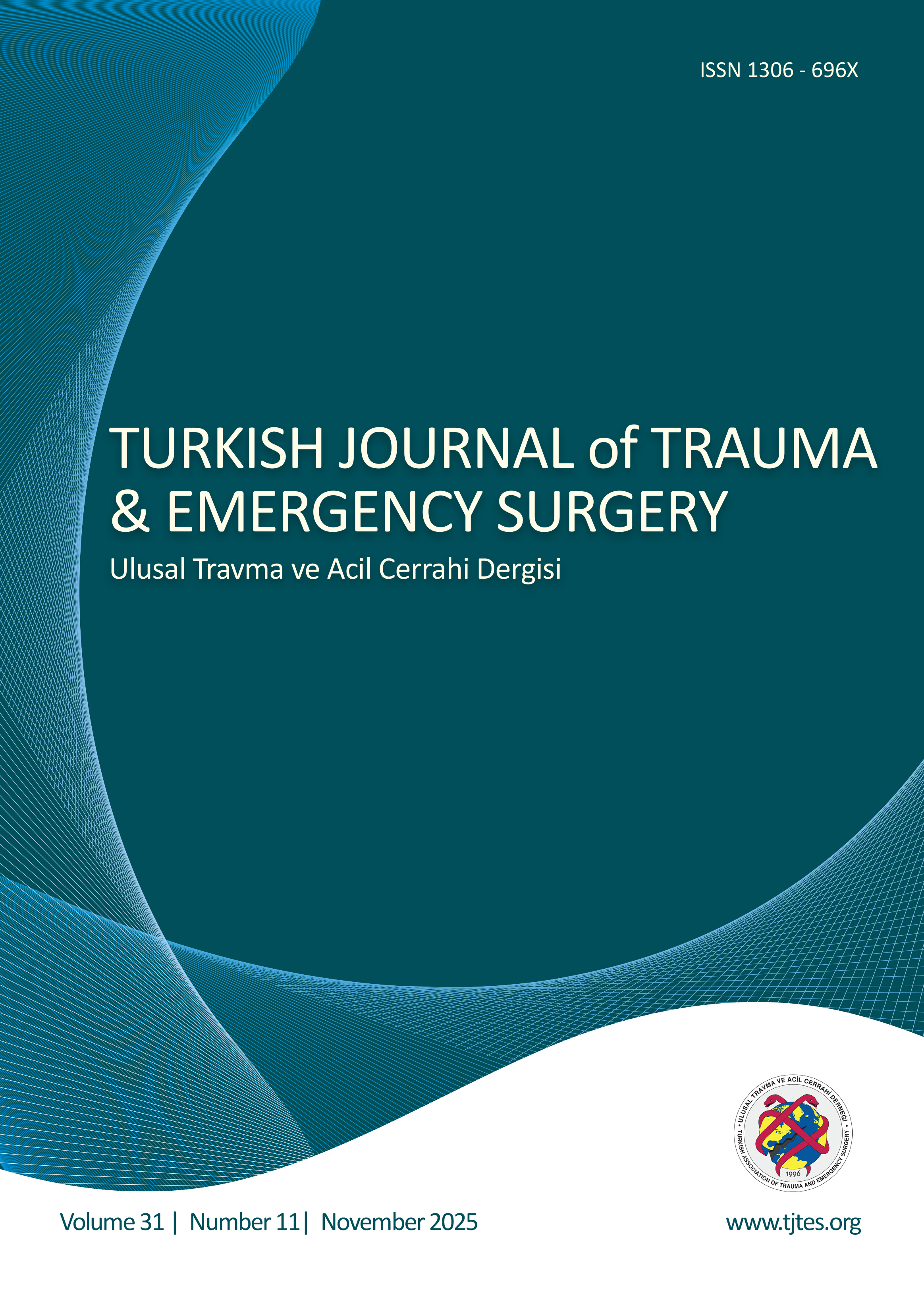Hızlı Arama
Akut apandisitin tıbbi tedavisinin devam edilmesinde immatür granülosit sayısı ve yüzdesi önemli mi? İleriye yönelik randomize kontrollü çalışma
Mehmet Buğra Bozan1, Fatih Mehmet Yazar1, Ömer Faruk Boran2, Özlem Güler3, Ayşe Azak Bozan41Kahramanmaraş Sütçü İmam Üniversitesi Tıp Fakültesi, Genel Cerrahi Anabilim Dalı, Kahramanmaraş2Kahramanmaraş Sütçü İmam Üniversitesi Tıp Fakültesi, Anesteziyoloji ve Reanimasyon Anabilim Dalı, Kahramanmaraş
3Kahramanmaraş Sütçü İmam Üniversitesi Tıp Fakültesi, Acil Tıp Anabilim Dalı, Kahramanmaraş
4Necip Fazıl Şehir Hastanesi, Anesteziyoloji ve Reanimasyon Bölümü, Kahramanmaraş
AMAÇ: Her ne kadar apendektomi akut apandisitte halen küratif tedavi olsa da, komplike olmamış olgularda tıbbi tedavi ön plana çıkmaktadır. Bu çalışmada immatür granülosit (IG) sayısı ve yüzdesinin komplike olmamış akut apandisitin tıbbi tedavisinin başarısındaki rolünün değerlendirilmesi amaçlandı.
GEREÇ VE YÖNTEM: Temmuz 2019 ile Nisan 2020 tarihleri arasında akut apandisit olguları ileriye yönelik olarak kayıt edildi. Hasta seçiminde top çekme kullanılarak hastalar tıbbi tedavi grubu (Grup M) ve apendektomi grubu (Grup A) olarak ikiye ayrıldı. Grup M, takibin 24. saatinde tıbbi tedavinin başarılı olduğu (Grup MR) ve olmadığı (Grup MF) olmak üzere iki alt gruba ayrıldı. Başvuru anındaki ve takibin 24. saatindeki IG sayısı ve yüzdesi, C-reaktif protein (CRP) düzeyleri, nötrofil lenfosit oranları ve beyaz küre değerlerindeki değişimler incelendi.
BULGULAR: Çalışmaya dahil olma kriterlerini karşılayan 64 hasta çalışmaya alınarak 31 hasta Grup Ada ve 33 hasta Grup Mde takip edildi. Alt grup incelemesinde Grup MFde 11 hasta yer alırken Grup MRde 22 hasta izlendi. Takibin 24. saatinde IG sayısı ve yüzdesi Grup MFde diğer gruplara oranla yüksek izlendi (IG sayısı için: Grup A ile Grup MF, p=0.002; Grup A ile Grup MR, p=0.111; Grup MR ile Grup MF, p<0.001) (IG yüzdesi için: Grup A ile Grup MF, p=0.001; Grup A ile Grup MR, p=0.809; Grup MF ile Grup MR, p=0.001). Grup MRde izlenen IG sayısı ve yüzdesindeki azalma IG sayısı ve yüzdesinin etkili olduğunu gösterdi [IG sayısı için: F(148.862)=61, p=<0.001, η2=0.707] [IG yüzdesi için: F(10.157)=0.252, p=<0.001, η2=0.504].
TARTIŞMA: IG sayısı ve yüzdesi komplike olmamış akut apandisit olgularında tıbbi tedavinin başarısını değerlendirmede etkilidir ve komplike olma-mış akut apandisit olgularında tıbbi tedavinin devam edilmesine yol göstermektedir.
Anahtar Kelimeler: Delta nötrofil indeksi, immatür granülosit sayısı, immatür granülosit yüzdesi, komplike olmamış akut apandisit; komplike olmamış akut apandisitin nonoperatif tedavisi; nötrofil lenfosit oranı.
Are the immature granulocyte count and percentage important in continue medical treatment in acute appendicitis? A prospective, randomized, and controlled study
Mehmet Buğra Bozan1, Fatih Mehmet Yazar1, Ömer Faruk Boran2, Özlem Güler3, Ayşe Azak Bozan41Department of General Surgery, Kahramanmaraş Sütçü İmam University Faculty of Medicine, Kahramanmaraş-Türkiye2Department of Aenesthesiology and Reanimation, Kahramanmaraş Sütçü İmam University Faculty of Medicine, Kahramanmaraş-Türkiye
3Department of Emergency Medicine, Kahramanmaraş Sütçü İmam University Faculty of Medicine, Kahramanmaraş-Türkiye
4Department of Aenesthesiology and Reanimation, Necip Fazil State Hospital, Kahramanmaraş-Türkiye
BACKGROUND: Although appendectomy is still a curative therapy for acute appendicitis, medical treatment has come to the fore in uncomplicated cases. This study aimed to determine the importance of immature granulocyte (IG) count and percentage for the role of medical treatment success in uncomplicated acute appendicitis.
METHODS: Acute appendicitis cases were prospectively registered between July 2019 and April 2020. Using ball drawing, patients were divided into two groups as medical treatment (Group M) and undergo appendectomy (Group A). Group M was divided into two subgroups as those who responded to medical treatment medically responded (MR) and failed medical treatment (MF) within 24 h of follow-up. Changes in IG count and percentage, C-reactive protein levels, neutrophil-lymphocyte ratio, and white blood cell count between initial administration and 24th h of follow-up were examined.
RESULTS: Sixty-four patients who met the inclusion criteria were followed as 31 patients in Group A and 33 in Group M. At Sub-group MF 11 patients and Subgroup MR 22 patients were followed up. At the 24th h of the follow-up, the IG count and percentage were higher in the Group MF (for IG count: Between Group A and MF, p=0.002; between Group A and Group MR, p=0.111; and between Group MR and MF, p<0.001) (for IG percentage: Between Group A and MF, p=0.001; between Group A and MR, p=0.809; and between Group MF and MR, p=0.001). This decrease in the IG count and percentage suggests that the response to medical treatment was effective [for IG count: F (148.862) = 61, p≤0.001, η2=0.707] [for IG percentage: F (10.157) = 0.252, p≤0.001, η2=0.504].
CONCLUSION: IG count and percentage are effective for evaluating the success of medical treatment of uncomplicated acute ap-pendicitis and they guide in the decision to continue medical treatment of uncomplicated acute appendicitis.
Keywords: Delta neutrophile index, immature granulocyte count, immature granulocyte percentage, neutrophile lymphocyte ratio; non-operative management of uncomplicated acute appendicitis; uncomplicated acute appendicitis.
Makale Dili: İngilizce





